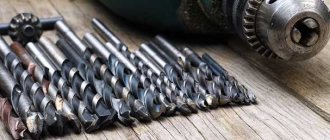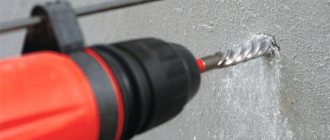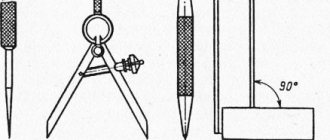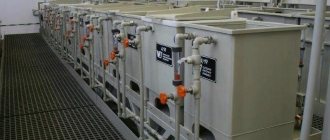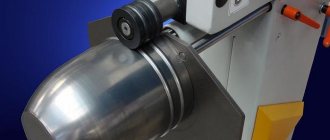01/27/2021 Author: VT-METALL
Issues discussed in the material:
- Selection of drills for drilling metal
- Marking metal before drilling
- Methods for drilling metal
- Metal drilling devices
- Final Recommendations for Drilling in Metal
Methods for drilling metal are selected depending on the parameters of the workpiece itself and the type of hole that needs to be made. The choice of auxiliary devices and lubricants also depends on the specifics of the task. In general, the drilling technology is simple, but it requires knowledge of the nuances in order to obtain a high-quality product.
It is also important under what conditions the drilling occurs. For household operations, accuracy and speed may be of secondary importance, while in manufacturing these parameters come to the fore. In our article we will tell you what methods of drilling metal exist and how to prepare the workpiece for this operation.
Selection of drills for drilling metal
Drills are needed to make holes in metal. They are rods made from an alloy that must be harder than the workpiece material. Such devices are made from steel with the designation HSS - grades P18, P6M5, P9 (high-speed steel) or use hard alloys specially created for working with hard-alloy, hardened parts. Their brands are VK and T5K10.
Drills consist of three main parts:
- edges that are designed to penetrate holes and remove a thin layer of the material being processed;
- spiral cutting, designed for removing chips from the hole;
- shank used to secure the drill bit in the tool.
First, let's take a closer look at the cutting edges. They are bevels converging at the top, forming a jumper. The angle of convergence of the bevels, called the main one, varies and depends on the selected processing mode of the workpiece and its material.
The angle is standardized:
- for stainless and hard steel the angle should be from 135° to 140°;
- for structural steel – 135°;
- for aluminum, brass and bronze – from 115° to 120°;
- for copper – 100°;
- for cast iron - clearance angle is 120°, and the edge sharpening angle is 90°.
The drill has two edges, which are sharpened at an angle from 20° to 35°. They determine the sharpness of the instrument. The edge angle is called the back angle. The drill touches the workpiece surface in accordance with this parameter. At the same time, there will be free space behind it. This shape makes it easy to remove and throw away chips from the work site. The angle can be different, sometimes it is up to 90°. Increasing its value is necessary for processing fragile workpieces made of materials such as brass, cast iron, and bronze.
Spiral cutting is grooves that help remove chips. Each of them has its own edge. Their planes are always parallel to the axis of rotation of the drill. This edge is called “ribbon”. Its task is to clean the walls of the hole being made with the centering of the drill.
The difference between a drill and a drill
When the structure of a concrete drill for a hammer drill is known, it is not difficult to distinguish it from a drill bit. However, many beginners find it difficult to choose the right attachment for their tool model. First you need to decide what type of tool is planned for the work. If this is a drill with an impact option, then you need to buy an attachment in the form of a drill for concrete. If this is a hammer drill, then you need to choose drills. When buying, newbies say that they need a drill for concrete, and the seller asks what tool it is needed for - a drill or a hammer drill.
Let's figure out how a drill differs from a drill so that we know what to answer to the seller. So, the models under consideration differ, first of all, according to their purpose. The drill is intended for a hammer drill, and the drill bits are for drills. However, this difference cannot be called an argument, since there are known cases of using a drill fixed in a drill chuck, as well as a drill installed using an adapter in a tool chuck. It turns out that a concrete drill for a hammer drill is used, but only on the condition that it is a low-power tool, otherwise the attachment will not withstand heavy loads. Drills for a rotary hammer differ from drill bits for a drill by the following criteria:
- The design of the tail part is a cylindrical base with a diameter of 10 mm and 18 mm on the nozzle with corresponding grooves, but on drills there are no such grooves. In addition, the diameter of the drill shank corresponds to the size of the working part
- Diameters of the working part - you can drill concrete with a drill only with a maximum hole diameter of up to 14 mm, while the hammer can accommodate a nozzle with a diameter of up to 32 mm and even 55 mm for professional barrel hammer drills with an sds-max type chuck. To obtain large hole diameters, special concrete crowns are used
- Impact ability - knowing the main visual difference, let's move on to the secondary factors. Drills have lower productivity than the devices under consideration, which is due to their strength. The drill is designed for long-term work under shock load, and the drill is intended only for short-term drilling of concrete. If you install a concrete drill in a hammer drill chuck, it will break under prolonged loads
Drill and drill difference
You also need to take into account such a difference as the length of the working part of the nozzle. Concrete drill bits for drills are available with a maximum length of 300 mm, and drills can be so long that their distance reaches 1 meter. This is due to the fact that hammer drills have a large power reserve and also have high rates of creating impact actions. Drills use low-power electric motors, which, if they are suitable for chiselling concrete, are only suitable for short-term use.
This is interesting!
If you use a drill to drill concrete frequently, the result of such work will result in failure of the electric motor.
Usually the armature winding suffers, but the stator can also burn out. If you plan to drill concrete, brick, cinder block, reinforced concrete, as well as marble or granite slabs, then you will need not only a powerful electric unit, but also a high-quality attachment for it. If you need to buy a concrete drill for a rotary hammer, then choose models from well-known manufacturers who value their brand and produce high-quality products. You can buy drills not only in the nearest hardware stores, but also on the Internet.
In addition to the usual attachments, which are similar to a drill, there are also breakout drills. This is a type of replaceable elements for hammer drills, the main purpose of which is to make through holes for laying communications. They are available in sizes from 45 to 80 mm.
Now, when buying an attachment, you must correctly say that you need a drill or drill. If you say that you need a drill for concrete, and the seller asks you again. This means that he is not sure that you know the difference between a drill and a drill. Therefore, it won’t hurt to add “concrete drill bit for drill” once again.
https://youtube.com/watch?v=DWtHfhs7mvk%3F
Marking metal before drilling
Before you start drilling metal using different methods, be sure to mark the hole. Using a punch, mark the place on the surface of the product where the slot will be made. In addition to the center punch, a marker can be used. However, this is less convenient, since you will have to constantly monitor the location of the drill at the selected point. The punch makes a small depression at the drilling site. To do this, it is hit with a hammer. The resulting outline will be convenient for further work.
VT-metall offers services:
Precision can be increased by pre-drilling. Notches are made on the surface of the workpiece with a chisel, designed to guide the tool towards the hole.
We recommend articles on metalworking
- Steel grades: classification and interpretation
- Aluminum grades and areas of their application
- Defects in metal products: causes and search methods
If it is necessary to produce several holes in workpieces, a template is used. Thus, several sheets of metal are drilled at once, which are connected with a clamp.
A jig is used to make precise holes that must be angled. This is a small strip with templates for holes located on it. Such devices are used in various industries.
Currently, several types of conductors are used, for example:
- universal;
- fastened;
- turning;
- sliding;
- overhead.
Processing options
Using the procedure of deep drilling or reaming, you can obtain holes that will be characterized by the 10th or 11th degree of surface roughness quality. If it is necessary to obtain a higher-quality hole, then after completion of the processing process it is necessary to additionally countersink and ream it.
In order to increase the accuracy of work, in some cases you can resort to carefully adjusting the position of the machine and correctly sharpening the consumable element. A method is also used in which the work is carried out through a special device that increases accuracy. This device is called a conductor. There is also a division of drills into several classes. There are spiral drills with straight flutes, feather drills used for deep or annular drilling, and center drills.
Methods for drilling metal
1. Simple drilling.
A familiar technique for making holes in metal:
- Surface marking.
- Marking the location of the future hole with a center punch and hammer.
- Clamping the workpiece with a vice or clamp.
- Installing a drill of the selected diameter into the tool.
- Tool centering.
- Drilling a hole (blind or through).
2. Reaming.
Reaming a workpiece is a technology for increasing the diameter of a hole that was previously made using drills of a larger diameter.
When working in small-scale production or at home, stage-by-stage drilling is used. It occurs by a gradual increase in the diameter of the tool. The reason lies in the tool used, which cannot immediately make a hole significantly different from the existing one in a thick product. With step-by-step drilling, the axial pressure on the tool (drill) is significantly reduced, which reduces the possibility of breakage.
3. Reducing the diameter at the depth of the hole.
The technology consists of several stages. First, a thick drill is used, and then a smaller diameter.
4. Technology of deep drilling of workpieces.
According to technology, holes are considered deep if their diameter is 25 or more times less than its length. The work is complicated by the need to stop drilling and remove chips from the hole, as well as lubricate it with coolant. It is used to cool the drill and helps prevent its deformation (or breakage).
Deep drilling involves the use of various types of cutting fluids. The most effective of them are the following:
| Product material | coolant |
| Heat-resistant and stainless alloys | The composition includes sulfofresol and oleic acid in a proportion of 80x20%. Instead of sulforesol, you can use a mixture of sulfurized oil (50%) and kerosene (30%) |
| Aluminum and its alloys | Various mixed oils, emulsion, kerosene are used. Drilling can take place without cooling |
| Nickel | Emulsions |
| Copper | Mixed oils and emulsions are used. Drilling can take place without cooling |
| Brass | 3–5% emulsion. Drilling can take place without cooling |
| Zinc | Emulsions |
| Bronze | Blended oils. Drilling can take place without cooling |
| Iron casting | 3–5% emulsion and kerosene. Drilling can take place without cooling |
| Malleable iron | 3–5% emulsion |
| Alloy steel | Mixed oils |
| Tool steel | Mixed oils |
| Structural steel | Kerosene and sulfurized oil |
| Carbon steel | Emulsion and sulfurized oil |
Deep drilling occurs using special metal drills (core, spiral). Cooling fluids are supplied automatically. Machines for making deep holes are equipped with special automatic feeding systems.
Deep drilling should be done slowly, with stops, removing the drill from the hole, and clearing it of chips. Drilling using twist drills occurs in several stages, with the tool changing from a small diameter to a larger one.
5. Technology for processing thick sheets of metal.
Sheets of thick metal are drilled using core or cone drills. Their choice depends on the required hole diameter. If it is less than 30 mm, then use conical ones. If more, then use core drills. They are installed in high-power drills or in special drilling machines, which must operate at the lowest speeds.
The most effective technology for making holes using core drills is recognized. The reason is low energy costs. In addition, the holes are precise with smooth walls.
6. Technology for making holes in thin sheets of metal.
Thin sheets of metal are drilled, as a rule, with conical drills, gradually increasing their diameter. In this way, deformation of the workpieces is avoided.
If there are stepped cone drills, then they are used. Using marked steps makes it much easier to make multiple holes of different diameters (or just one) on a sheet of thin metal.
7. Features of manufacturing through holes in metal blanks.
An important step in through drilling is to protect the working surface from damage by the drill when it exits from the back side of the workpiece. There are several ways to prevent furniture damage:
- Drilling is carried out on workbenches equipped with holes.
- A wooden block or a metal device with holes for the passage of the drill is placed under the workpiece.
- Significantly reduce the processing speed at the end of drilling.
8. Features of manufacturing blind holes in metal blanks.
Holes of a certain depth are called blind. There are a number of methods for installing it:
- a special ruler with which the machine is equipped;
- using sleeve stops for drills;
- limiting the drilling depth with chucks on which the stop is adjusted.
Feeding systems on modern equipment are automated, which greatly simplifies the production of blind holes in metal. To do this, work parameters are set.
Important! The technology for producing long blind holes in parts made of thick sheets of metal involves stopping and removing chips from the hole.
9. Technologies for making complex holes in metal products.
Complex holes are considered, for example, half holes, which are made at the edge of the part. They do this as follows:
- use a vice to clamp parts or workpieces with a tightly pressed lining;
- center the drill at the joint of the workpieces;
- make a hole.
The process of drilling holes in cylindrical workpieces is more complicated. It is divided into two stages:
- a platform is placed perpendicular to the hole using a countersink or milling;
- the hole itself is made.
Angled holes are made as follows:
- a platform is being made;
- the lining is installed at the required angle;
- a hole is drilled.
Wood blocks are placed under the hollow parts before drilling. The production of holes with ledges occurs using the technology described earlier (drilling, reducing the diameter of the hole).
How to drill a wall with a crown
We take a standard diameter of 70 mm, because we are going to drill holes for sockets. The tool should be checked again; there should be no traces of soldering or welding on the crown. If there are any, it will simply be impossible to work, since this is a factory defect. As a tool, we will use the most common hammer drill, with an SDS plus shank.
It is advisable to use a hammer drill with a power of up to 800 watts inclusive; more powerful ones will exert very high pressure on the crown when drilling. And keeping the hammer drill evenly pressed against the wall is very difficult.
We will work exclusively in drilling mode, and not in impact mode. This small nuance must be clarified, otherwise it can easily lead to breakdown. The room in which the repair work will be carried out will be very dusty, and for this you need to buy a spray bottle to humidify the room itself, and not the crown. It is also worth considering the fact that when working with a powerful hammer drill, small fragments will fly in all directions, sometimes they are very sharp, here you need to buy personal eye protection, and take care of work clothes that will cover your arms and legs. Glasses will allow you not only to protect your eyes from unwanted injuries and damage, but also to completely control the entire process, rather than letting the work take its course.
Metal drilling devices
Various methods of drilling metal involve the use of cutting fluids. In most cases, they are used to reduce friction and equalize the temperature of the surface being processed and the tool. Good quality coolant will not cause corrosion, it is completely safe to use, it has no odor, and fully performs its function.
As a lubricant for drilling metal workpieces at home, you can take:
- Technical Vaseline - used primarily for drilling soft materials.
- Soap solution - used for aluminum parts.
- Turpentine with alcohol is used for silumin.
- A mixture of various oils is applied for processing steels (tool or alloy).
Sometimes a fairly universal lubricant composition is used, which is made from a mixture of laundry soap (200 g) and motor oil (20 g), followed by boiling to an emulsion.
There are industrial coolants. Their use makes it possible to increase the speed of work with different types of metal. Working with stainless steel is 30% faster. With cast iron the growth is even higher – 40%.
Types of shanks for corresponding hammer drill chucks
The tail part of the nozzle plays an important role, since it is this side of the nozzle that is installed in the hammer drill chuck. The easiest way to distinguish a drill from a drill is to compare their tail parts. If the drill has a cylindrical design, then on the drills the shank has special grooves. Experienced specialists will be able to determine without unnecessary difficulties whether the nozzle is suitable for the cartridge of a particular hammer drill.
To avoid difficulties when choosing drills for your rotary hammers, you need to understand their varieties. Based on the shape of the shanks, they are classified into the following types:
- SDS plus is a commonly found shank type with a diameter of 10 mm. The design of such a shank is presented in the form of a cylindrical base with grooves. These grooves are needed to connect to the tool chuck. There are 4 grooves on the nozzle, two of which are considered open or solid, and two closed. The length of the tail section on drills of the sds plus type is 40 mm, and the diameter of the working part ranges from 4 to 26 mm. Typically, such attachments with shanks are used to work with household and semi-professional power tools.
- SDS max - the main distinguishing feature of these shanks from sds plus is the diameter, which is 18 mm. In addition, the length of the part that is inserted into the tool chuck is also much longer and is 90 mm. The design of the grooves is almost identical to sds plus with a slight difference in their size, and the diameter of the working parts is from 26 mm. Bits with SDS max shanks are used in professional devices, as well as in jackhammers
- SDS top - this version of the tail section is less popular, and nozzles with an sds top shank are rarely found (the design is something between plus and top). The diameter of the cylindrical part is 14mm and the length of the inserted area is 70mm. Such drills are produced with working part diameter ranges from 16 to 26 mm
- SDS quick is an even less popular tail shape that was developed in 2008 by Bosch. The attachments with these shanks are significantly different from the previous ones, and they are more similar to drills. The hexagonal design of the shank has keys or protrusions instead of grooves, due to which the nozzle is fixed in the tool chuck. The advantage of this tail section design is that they are intended not only for use in hammer drills, but also in drills and screwdrivers. If you take a drill with this type of shank, then it is suitable exclusively for Bosch rotary hammers of the Uneo and Uneo Maxx models
- SPLINE is a new type of drill shank design for a concrete hammer drill, which has a spline design. This is a new type of shank for rotary hammers made in China. Spline shanks were developed by a Chinese company producing rotary hammers, which may have been the impetus for the transition from the usual sds plus and sds max to new devices. Today they are not very popular, but it is only a matter of time. Spline shanks on rotary hammer drills have proven their reliability and efficiency, so there is a high chance that you will soon have to replace the chucks on your outdated power tools. The SPLINE shank design is shown in the photo below
For ordinary household and even semi-professional models, standard drills with SDS plus shanks are used. These are the most popular models that are quickly inserted into the cartridge and also quickly removed from it.
Final Recommendations for Drilling in Metal
In conclusion, it is important to note the need to comply with safety regulations, as well as to prevent defects and accelerated wear of tools. Let's give some useful tips:
- Before starting drilling, always check that all parts of the tool and workpiece are secure.
- Clothing should be comfortable and not have parts that could get caught in the rotating parts of the machine. The use of safety glasses is mandatory.
- Contact with the workpiece should only occur when the drill is rotating. Otherwise, it will quickly become dull.
- The reverse movement of the drill when removing it from the hole should occur with the drill turned on at low speed.
Why drill and cut concrete?
When performing construction and installation work, as well as when decorating the interior of a residential premises, tasks always arise related to the processing of concrete structures.
The following important points can be added to the list of such tasks:
- dismantling of concrete structures;
- correction of shortcomings and omissions made by builders;
- cutting of various openings and niches;
- arrangement and fastening of furniture elements;
- performing facing and decorative works;
- hidden installation of power lines in an apartment or house;
- installation of ventilation and exhaust equipment;
- installation of plumbing equipment, etc.
As you can see, the operations of drilling and cutting concrete in domestic conditions are designed to perform various technical tasks of a domestic nature.



